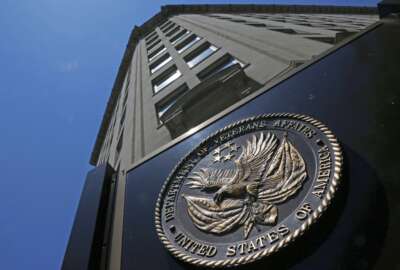Hubbard Radio Washington DC, LLC. All rights reserved. This website is not intended for users located within the European Economic Area.
DoD’s 2015 budget envisions smaller military with less generous benefits
The Pentagon says its spending plan acknowledges defense spending is on a downward trajectory, and reduces force structure in order to balance other priorities ...
wfedstaff | April 17, 2015 6:18 pm
The annual budget proposal the Defense Department will formally unveil next week will call for an overall reduction in the size of the military, along with some cutbacks to the benefits service members currently receive.
Both of these are decisions the Pentagon says are necessary as it attempts to preserve the military’s readiness.
In a preview of the line-by-line budget rollout the White House and all agencies will conduct next week, Defense officials said Monday they plan to trim back some large cost drivers in each military service.
For the Navy and Air Force, that will mostly mean trims to their planned purchases of weapons platforms.
For the Army and Marine Corps, it will mean tens of thousands fewer uniformed personnel. The Army, in particular, would be smaller than at any point since the U.S. entered World War II.
Pentagon officials say the budget still relies on the defense strategic guidance President Obama issued two years ago, but with some modifications that will entail more risk because of the military’s reduced size.
While the proposal will not include plans to cut military compensation outright, some benefits, such as health care and housing allowances, would be scaled back.
Defense Secretary Chuck Hagel said those changes represent a best-case scenario. They assume DoD will get tens of billions of dollars more money in 2015 than last year’s bipartisan budget agreement currently allows. They also imagine that lawmakers will bypass sequestration in 2016 and beyond.
If they don’t, Hagel warned, the picture will be far bleaker.
In the short term, the military would face readiness and acquisition shortfalls that significantly compound the problems the Pentagon faced beginning in early 2013, when many units were forced to cancel training activities, and routine facility upkeep fell off the priority list.
“In the longer term, after trimming the military enough to restore readiness and modernization, the resulting force would be too small to fully execute the President’s defense strategy,” Hagel said. “This plan balances a need to protect our national security with the need to be realistic about future budget levels. DoD has also completed a detailed plan should sequestration-level cuts return in fiscal year 2016 and beyond, as is the current law.”
Five-year increase
Overall, the Pentagon’s budget proposal would ask Congress for $115 billion more over five years than what is currently allowed by the 2011 Budget Control Act — the law which created sequestration.
In 2015, it would boost DoD’s spending authority via a one-year special fund the Obama administration will propose as part of the governmentwide spending request next week.
The Opportunity, Growth and Security Fund would add $58 billion to discretionary spending in 2015 via “spending and tax reforms” that the White House has not yet spelled out. DoD would receive $26 billion of that total.
“The money is specifically for bringing unit readiness and equipment closer to standard after the disruptions and large shortfalls of the last two years,” Hagel said. “The reason we are requesting this increase over sequestration levels is because the President and I would never recommend a budget that compromises our national security. Continued sequestration cuts would compromise our national security both for the short and long term.”
Defense officials said the department’s analysis shows that if sequestration stays in place in 2016, the Army, for example, would have to shrink to 420,000 soldiers, a size that the Pentagon believes is too small to adequately perform that service’s missions.
But even under DoD’s proposal, the Army would alter its previous plans to downsize its current force of 532,000 to 490,000 troops, instead, cutting back to somewhere between 440,000 and 450,000. The requested cuts also include a 5 percent reduction in the size of the Army Reserve and National Guard.
“This reduction is smaller than the 13 percent reduction in active duty soldiers,” Hagel said. “I’m mindful that many in the guard and reserve community and in Congress have argued that the reserve component should be protected from cuts, because they provide more troops at lower cost. If our priority was having the largest possible force in the event of a large-scale prolonged war, that would be reasonable. However, we must prioritize readiness, capability and agility. And while it is true that reserve units are less expensive when they are not mobilized, our analysis shows that a reserve unit is roughly the same cost as an active duty unit when mobilized and deployed.”
That’s true, said retired Maj. Gen. Gus Hargett, the president of the National Guard Association of the United States, one of the politically powerful organizations that’s certain to lobby Congress against a downsizing of the reserve component of the military.
But, he said, Hagel’s argument ignores the “pay-as-you-use-them” nature of the reserve forces.
“On most days, only a fraction of active-component personnel are actually in the fight or deployed in a quick-reaction capacity,” he said. “Most of the rest, which amounts to hundreds of thousands of personnel, are in reserve, just like the guard. One force the nation pays for every single day. One it does not.”
Fewer people, ships, planes
The Marine Corps, meanwhile, would shrink from 190,000 to 182,000 under the 2015 budget plan; sequestration after 2015 would mean no more than 175,000.
For the Navy, Hagel said he has decided to cap procurement of the service’s new littoral combat ship at 32 vessels instead of the 52 it had planned. If sequestration continues, the service would have to retire an entire carrier strike group.
The Air Force, meanwhile, will retire its entire fleet of A-10 attack jets, along with the venerable U-2 reconnaissance plane. That latter decision up-ends a call the service made two years ago when it decided a new variant of the Global Hawk unmanned vehicle was too expensive, and that reconnaissance missions could be better served by the 57-year-old U-2. Now, Global Hawk UAVs will take the U-2’s place.
With regard to compensation, the DoD budget will propose a 1 percent increase for both military and civilian employees in 2015, with the exception of generals and admirals, whose pay would be frozen for at least a year. Hagel said the department also would make unspecified “targeted cuts” in the ranks of DoD’s civil servants.
Without providing details, Pentagon officials said they would save money on health care by consolidating the TRICARE coverage system into a single insurance plan and adding new out-of-pocket costs for retirees and family members of active duty service members.
The budget does not include any proposals to modify the military retirement system. Officials said they wanted to await the conclusions of the congressionally-mandated Military Compensation and Retirement Modernization Commission before tackling the subject of pensions.
“The adjustments to military compensation presented in this year’s budget plan will enable each of the military services to invest in more critically important modernization and readiness while still allowing them to recruit and retain a high-quality force and offer deserved, generous, competitive and sustainable benefits,” Hagel said. “Although these recommendations do not cut anyone’s pay, I realize they will be controversial. Congress has taken some important steps in recent years to control the growth in compensation spending, but we must do more. A holistic and comprehensive approach must be taken to compensation changes. Continuous piecemeal changes will only magnify uncertainty and magnify doubts with our service members about whether promised benefits will be there in the future.”
Also, the military’s subsidized system of commissaries would get more expensive for their users. DoD currently estimates those shoppers save about 30 percent compared to private sector supermarkets. Under the budget proposal, that would fall to about 10 percent, a senior military official said.
Proposed cuts to housing allowance
DoD also plans to scale back the tax-free housing allowances military members currently receive. Right now, DoD calculates those stipends to cover 100 percent of the average housing costs in a given geographic area. Under the changes, they would cover only about 95 percent.
Despite recent failed attempts, DoD again will ask Congress for permission to close domestic military bases.
“I am mindful that Congress has not agreed to Base Realignment and Closure requests in the last two years. But if Congress continues to block these requests, even as they slash the overall budget, we will have to consider every tool at our disposal to further reduce infrastructure,” Hagel said. “DoD has already been reducing infrastructure where we can. In Europe, where BRAC authority is not needed, we have reduced our infrastructure by 30 percent since 2000. And a European infrastructure consolidation review this spring will recommend further cuts, which DoD will pursue.”
The preview of next year’s budget rollout was met by reactions that might be expected to follow tough decisions a public bureaucracy must make when forced with decisions about how to manage declining resources.
They fell largely along predictable lines. Military groups objected to the housing payment and other benefit cuts. Reserve component advocates said they were angered by the decision to draw down the guard and reserve force. And the tone of reactions from lawmakers who closely manage Defense matters fell mostly along partisan lines.
“The budget preview reflects the difficult budget environment forced on the Department of Defense by Congress,” said Rep Adam Smith (D-Wash.), the ranking minority member on the Armed Services Committee. “Our military leaders are doing their best to put forward a budget that provides national security. The preview outlines some tough choices, and I look forward to reviewing the budget in its entirety.”
Rep. Rob Wittman (R-Va.), the chairman of the Armed Services Committee’s subcommittee on readiness, was more skeptical.
“I have serious concerns about where the administration is placing its priorities when it comes to our nation’s national security,” he said. “I look forward to seeing the full, detailed release of the President’s budget next week. We can continue to cut away at discretionary spending and force the Defense Department to bear the brunt of those cuts, or we can get serious and start addressing the real drivers of our debt. We must not and cannot balance the budget on the backs of our military men and women.”
Defense officials say they’re fully cognizant of the fact that several of their current cost-saving proposals have been tried before and summarily shot down by Congress. But they say their task over the next several months will be to make a convincing case that the military will be in much worse shape if lawmakers continue to block them.
“We need to make as clear as we can what it means to operate at these different funding levels and the trades that are involved in those budget lines,” a senior defense official said. “That’s the best argument I know to make to the Congress. If somebody wants to add money back in for their program, without additional money, it’s got to come from somewhere else, and we have looked for a long time and in great detail at everything. There’s no more money to take, so it has to trade with something. I hope Congress will behave like partners with us this time.”
RELATED STORIES:
DoD budget guidance aims for leaner, more agile military
Obama signs bipartisan budget deal, defense bill
DoD braces for a future of degraded military readiness
Copyright © 2024 Federal News Network. All rights reserved. This website is not intended for users located within the European Economic Area.
Jared Serbu
Jared Serbu is deputy editor of Federal News Network and reports on the Defense Department’s contracting, legislative, workforce and IT issues.
Follow @jserbuWFED





